Do-it-yourself workbench for the garage: a guide to assembling it at home
Do you like to repair home appliances and make useful home gadgets with your own hands? For such work, you definitely need an equipped place - a workbench.Buying one is not cheap, and choosing the right size is very difficult, isn’t it?
But this issue can be solved in another way - to assemble a workbench with your own hands in the garage, using scrap materials. In this case, the first two problems will disappear by themselves, because the financial costs for it will require little, and making the workbench exactly the way you see it will not be difficult. Moreover, the choice of materials is also yours.
We will consider in detail the procedure for making a workbench and recommendations for choosing materials for it in this publication. We will supplement the presented material with visual photos and videos.
The content of the article:
Types and structure of a workbench
Before you get to work, you need to figure out what exactly you want and for what purposes. Workbenches are a familiar and irreplaceable thing. However, if you want to make a high-quality and durable design, you should think through all the details.
The workbench is:
- carpentry;
- locksmith;
- universal.
It is important to understand that a workbench is not just a table, but an entire work area where all the tools are at hand. And the main place is usually occupied by a vice.
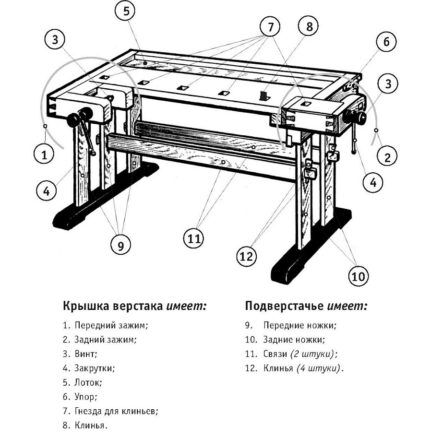
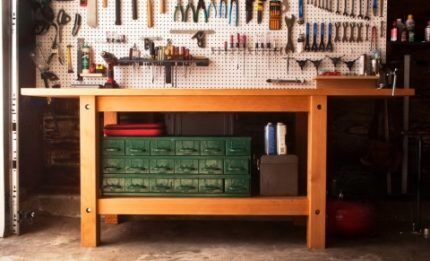
Have you set out to assemble a workbench yourself? This is a very real matter, although not so simple. Moreover, there are much more advantages in this than disadvantages. First of all, these are minimal financial costs. It is unlikely that you will be able to make a workbench completely free of charge from scrap materials, but still, the price will be cheaper than a factory one.
And the second point is that you can make it exactly the size of the room where you plan to place it, equipping it, if desired, with additional drawers and shelves.
Step-by-step assembly instructions
To assemble a workbench yourself, you will need step-by-step instructions, accuracy and the following tools:
- Bulgarian;
- welding machine;
- screwdriver and screwdrivers;
- roulette;
- drill;
- jigsaw;
To make the entire structure with your own hands, you need, at a minimum, to be able to work with metal and have welding skills.
Step 1 - drawing up a drawing
So, the first thing to start with is to decide on the size of the workbench, for which you will have to find a place to install it. Most often, such a table is placed in a garage or other premises convenient for work.
Not every garage has a large area, so before you start work, you will have to work hard with a tape measure. You need to calculate the space for the equipment so that it is convenient to work with.

So, we found a place, wrote down the dimensions of the future workbench, taking into account the width, height and length, as well as the working area nearby.
Next comes the complex process of creating a drawing. You can take the finished one and make your own edits. So, for example, corners (or one corner) can be beveled if the dimensions of the garage do not allow for such a structure or if nearby objects interfere.

Whether there will be shelves, hooks or cabinets above the workbench is also up to you. But all wishes must be taken into account before you start assembling the entire structure.
To do this, you can make an approximate list of tools that will be stored on your workbench and determine places for them - cabinets, shelves, hooks, drawers.
Step 2 - selection of materials
After sketching the project, you need to decide what to make the structure from. The supporting element (frame) is made of durable material (metal plates and pipes), since everything will be supported on it. The thicker and heavier the metal, the more stable the entire structure will be.
The frame can be cook it yourself or take it from an old workbench. Cooking the frame is not as difficult as it seems: you need to make high-quality detailing, numbering all the parts and correctly calculating their dimensions in mm. According to these parameters, prepare all parts of the iron frame.

The type of material depends on your preference. For example, let's take a workbench with a metal frame, a wooden tabletop, additional drawers, shelves and a metal panel for tools.To assemble it you will need: steel strips, pipes, angles, plywood sheets, boards, screws, bolts, hooks, nails, guides, fire-resistant coating, paint for metal and wood, a metal plate for the shield.
Step 3 - frame assembly
Now we have to assemble all the parts into a single structure - the frame of the workbench. If you don't plan to move it, secure the legs to the floor with anchor bolts or screws to keep it from wobbling or moving when you work.
If welding parts of the frame are not carried out in the room itself, take into account the dimensions of the doorway. Since the design does not mean that it can be folded, dragging a large table will be quite difficult.
We firmly weld all parts and grind off all sharp protruding parts. Be sure to cover the structure itself with metal paint.
Step 4 - Attaching the tabletop
The tabletop must be strong to withstand hammer blows and the weight of all tools (on average about 200 kg). It can be made of metal or wood, without sharp cutting edges that could injure or tear clothing.
All wooden surfaces used to create a workbench must be treated with a fire-resistant compound!
The tabletop must be firmly screwed or welded (if it is metal) to the frame. The best option is to use wood and iron. For example, choose a wooden tabletop, but cover it with a metal plate on top. This design will be impact-resistant and durable. And when working with liquids, such as machine oil and others, it can be easily put in order.
Special attention should be paid to the space on the tabletop for the vice. When choosing them, you should always consider weight.
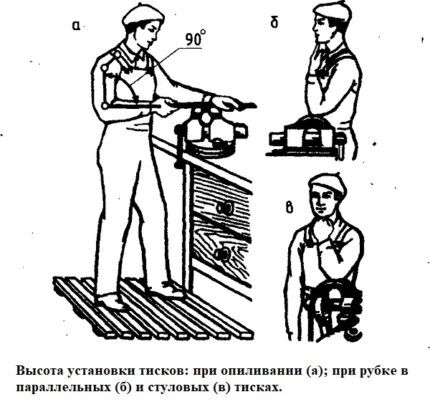
Step 5 - Adding Shelves and Drawers
The more space allocated for a workbench, the more shelves and drawers you can make. You can use lighter material to make drawers if you are going to store small tools in them. For example, sheets of plywood.
It is better to calculate and prepare all materials in advance, the number of sheets of plywood, handles, sizes and number of furniture guides, screws, nails and other things.
When calculating the parameters of the drawer, you should definitely take into account the place for attaching the guides. A cheaper option is to nail small bars instead of guides. But there is a big disadvantage here: when pulling out the box, difficulties may arise, since there will be no convenient and movable wheels.
It is better to choose handles for drawers without sharp corners and not protruding too much, otherwise they will cling to clothes.
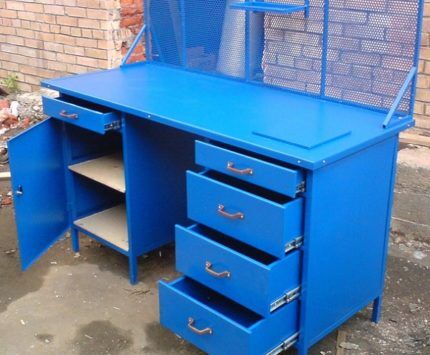
Instead of drawers and shelves, you can attach one large shelf under the table top, on which tools can easily fit. It won’t look beautiful, but the functionality and minimal waste of time for making such a structure will fully justify themselves.
Step 6 - Creating a Shield
An important attribute when arranging a work area in a garage is a toolbox. It can hang separately on the wall or be attached to the workbench structure itself.
The choice of material for the shield is individual: it can be made of either wood or metal. You can combine two materials, which will be even more interesting.You can hang hooks on it or place pockets where you can also hang various tools.
If you choose a wooden shield, then it is best to attach it to a metal frame, and only then attach it to a wall or workbench.
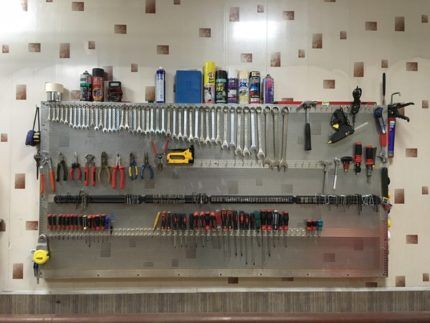
Since a workbench is a workplace, it is worthwhile to use the space around it wisely, especially if the area of the room (in this case, the garage) does not allow for full development. Next to the desktop you can also arrange storage areas: various shelves, drawers, cabinets, which you can also make yourself.
Step 7 - lighting arrangement
Special attention should be paid to lighting the entire work area. There are many options for garage lighting, but it is better to choose a lamp that will illuminate a specific area rather than the entire room. Spot light distribution provides the desired level of illumination without wasting energy.
By the way, you can also make a lamp for lighting a workbench with your own hands, showing imagination and ingenuity.
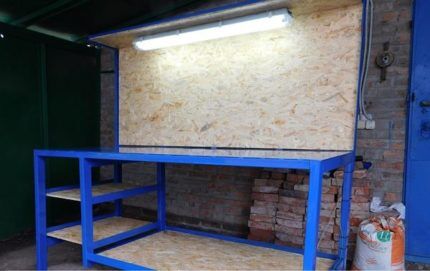
It's good for you! Rating of the best bench and machine vices: characteristics, pros, cons, price.
Conclusions and useful video on the topic
Video on how to make the frame, tabletop and shield of the workbench yourself:
How to weld a metal workbench in the following video:
If you correctly calculate the parameters, create a durable structure, and follow all safety rules, the workbench you make will last a long time, and it will be convenient and pleasant to use, because it was created taking into account your needs and wishes.
For assembly, you can use available materials, equip the table with shelves and drawers for storing small items, and also equip the space around it so that everything you need is “at hand”.
What kind of workbench do you use? Tell us about the manufacturing process, share original photos of the finished desktop for processing metal and/or wood products - the feedback form is located below. Here you can also express your opinion on the feasibility of making a homemade workbench and give assembly recommendations to beginners, guided by knowledge and personal experience.



